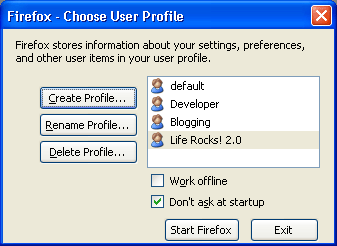

One thing I found helpful was to add a theme to the new profile, to make the different profiles more obvious. To see the changes you must log out and log in again, or restart the computer. the -P work argument launches Firefox with the named profile and the -no-remote argument opens a new Firefox instance. The last three lines are the new Dash menu item. Name=Open a New Work From Home Profile Window desktop file with the “work” profile added:Īctions=new-window new-private-window work-from-home-profile Edit the “Actions” line at the end of the first section to include the name of your new menu action, and then add that action below (or in place of) the existing sections. To add a menu item that launches the new profile, you only make two changes to this file. MimeType=text/html text/xml application/xhtml+xml application/xml application/rss+xml application/rdf+xml image/gif image/jpeg image/png x-scheme-handler/http x-scheme-handler/https x-scheme-handler/ftp x-scheme-handler/chrome video/webm application/x-xpinstall Keywords=Internet WWW Browser Web Explorer Open a Terminal window and execute the following command. This should also work perfectly on Ubuntu 18.04 Bionic Beaver and later, as well as recent versions of GNOME Shell.įirst, copy Firefox’s existing system launcher to a special user directory for custom launchers. Even if an instance of Firefox is already running, you can launch a second or third with each using different profiles. Now that you have the second profile ready, let’s add it directly to the Dash menu, so you can choose which profile to launch. The about:profiles page showing the new profile has become the default - reverse that. That probably is not what you want so click the “Set as default profile” button under the “default-release” profile to reverse the changed setting. One thing to highlight here before continuing, is that when you create the new profile it becomes the default profile. The about:profiles page with the newly created profile highlighted. In testing I had problems with names using spaces or hyphens (such as “work-from-home”) so keep it short and simple. Name it whatever you like, but for this example I’ve simply named it “work”. Now click the grey “Create a New Profile” button and follow the Create Profile Wizard. The about:profiles page with Create a New Profile button highlighted. When you click the “Remove” button to get rid of it you are offered the option to keep the directory if you aren’t 100% certain. The profile named default-release is the default actually in use and you can safely remove the profile named “default” because the name is confusing.
#FIREFOX PROFILE MANAGER ON LAUNCH INSTALL#
You probably have two already because Firefox 67+ uses a dedicated profile for each update channel and on a fresh default Ubuntu 20.04 install two profiles named “default-release” and “default” already exist. Type about:profiles in the address bar to start Firefox’s Profile Manager. You can manage Firefox profiles while it is already running by visiting about:profiles or using an add-on, but adding them to the Ubuntu dock’s menu in the left sidebar gives you better usability (try about:about to see all the about: pages, there are many).

Default and custom Firefox dock launchers side by side


#FIREFOX PROFILE MANAGER ON LAUNCH HOW TO#
Most people just use the default one, but with so many people working from home during the current health crisis this is a good time to explain how to add a second profile for work tasks. Firefox uses profiles to store all your preferences, add-ons, and user data.


 0 kommentar(er)
0 kommentar(er)
